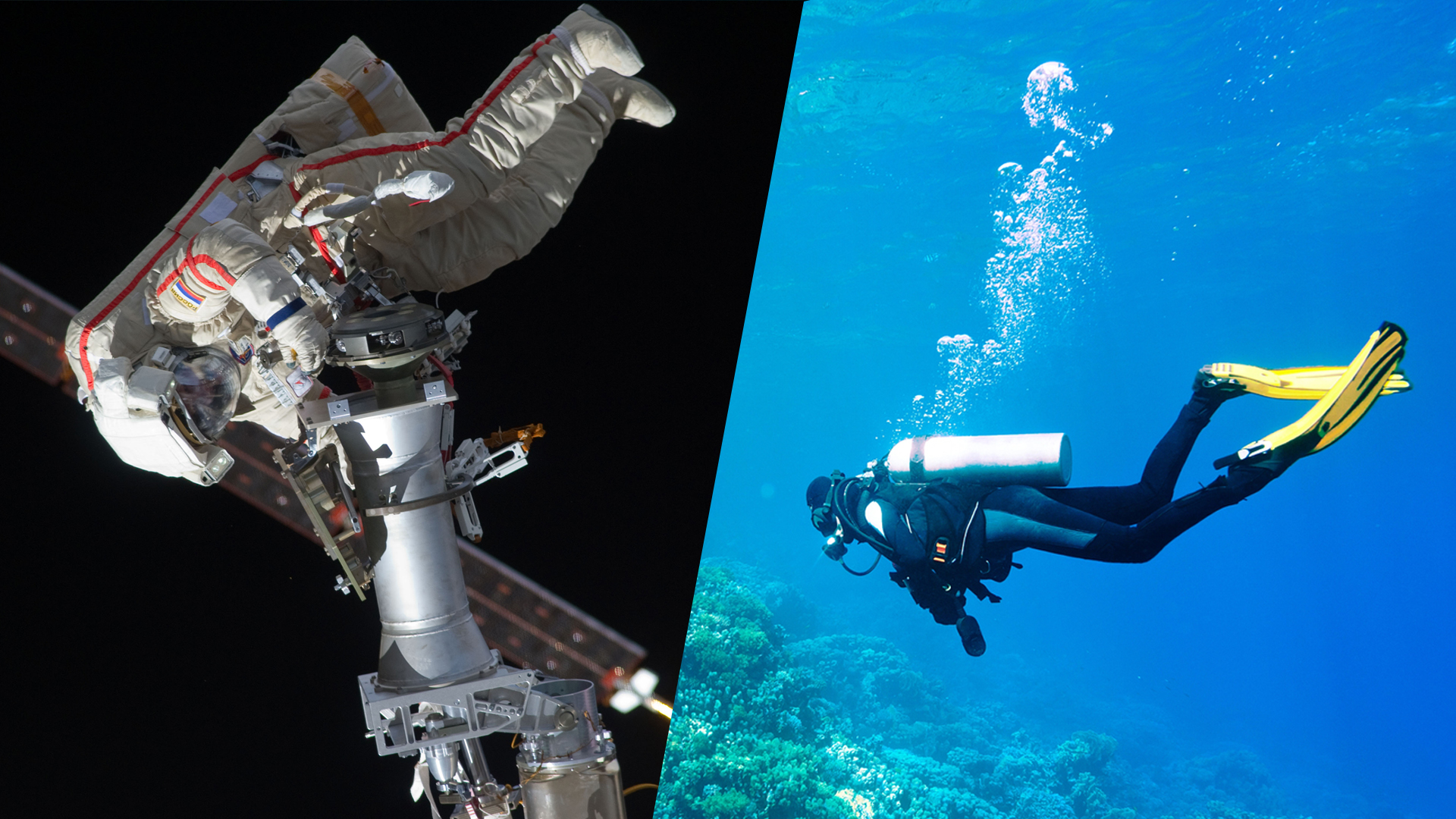Space and the open ocean: At first glance it seems as if two vastly contrasting places couldn’t possibly exist. But on the contrary, the two are more closely linked than you think. And people who have been to the furthest reaches of both can attest to this. Because it turns out that the types of training and experience needed and the environments you’ll find in both have impressive parallels.
Just ask aeronautical engineer, astronaut and aquanaut Nicole Stott. She has spent 104 days in space on the Space Station and Space Shuttle and a lot of time underwater, partly in preparation for space travel, but also for fun and education now that she spends most of her time on planet Earth.
The PADI-certified diver (Professional Association of Diving Instructors) confirms that undersea and in space have a lot in common. After all, both are extreme environments that are not only difficult to access, but often downright dangerous, requiring highly specialized equipment to navigate, and inhospitable to humans. That turns out to be quite handy, because while simulating the lack of gravity and vacuum of space can be tricky, the ocean provides a legitimately analogous and impressive simulative training ground.
In fact, before astronauts even think about setting foot in a shuttle to travel beyond Earth’s atmosphere, they have to spend time underwater. There is even a special training center for this: the Neutral Buoyancy Laboratory in Houston, which exists to train astronauts for space walks. Inside, one of the largest indoor swimming pools in the world – 60 meters long, 30 meters wide and 12 meters deep and holding 6.2 million liters of water – is also home to replicas of International Space Station components, as well as others by the man-made structures in space.

In this pool, astronauts wear 300-pound suits plus plenty of other equipment to achieve neutral buoyancy, and submerge, surrounded by a team of support divers, to learn and feel what it will be like to be in space to operate and move around. In fact, according to Stott, this is the closest feeling you can get to Earth, simulating what it’s like to move in space (minus the drag and weight you experience underwater).
After all, in both places you float – albeit in water because you float and in space because there is no gravity – and in neither you can just call it a day, take off your helmet or gas mask and walk home. .
That’s why Stott and others also trained at the Aquarius Lab, an underwater habitat and aquanaut base camp 60 feet below the ocean’s surface near the Florida Keys. She spent 18 days below the surface. Down there, “you’re in a real, real, extreme environment,” Stott explains, just like you would be in space, albeit with much more atmospheric pressure. But being at those depths not only simulates the movements and teamwork required outside Earth’s atmosphere, it also mimics the feeling of isolation and self-reliance.
“You can’t just bail,” Stott explains. When you are underwater at great depths, your body and blood become too saturated with nitrogen to quickly retreat to the surface if you get into trouble. If you do, the excess nitrogen can cause bubbles to form in your blood and/or lungs, which can cause serious bodily harm and decompression sickness or even death from arterial gas embolism. At the depths of Aquarius, Stott explains, saturation occurs if you are there for only 60 minutes.
Sure, there’s a relatively safe “indoor” environment to retreat to—similar to living in a spaceship—but in both locations, “If something goes wrong, you and your crew have to figure out how to get in a safe place.” configuration, including accounting. for your crew members.”
Everything about it is a perfect analogy for space, she continues: how to communicate, act with your crew and mission control team, live in tight spaces, use specialized equipment and the way to handle emergencies. It’s just that in one case you’re under pressure surrounded by water and in the other you’re dealing with the deadly vacuum of space.

“It’s the ultimate parallel to the extreme environment of space,” says Stott, even more so than other training astronauts have to endure, including cold weather and wilderness survival. But in such situations, she explains, you know help is just a satellite phone call away. Deep in space or deep underwater, it all comes down to self-survival, working as a team and knowing how to handle stress in a high-stakes environment. “It’s a completely different psychological experience,” Stott adds.
Diving certification is not required for those who dream of becoming astronauts, whether professional or space tourists. But Stott says if you don’t have diving experience yet and your astronaut application is accepted, you’ll get that certification and experience quickly.
For those who prefer to go in prepared or want to experience what space feels like here on Earth, Stott is more than excited to provide an introduction. In fact, she just completed her second Island Astronaut Camp in partnership with PADI and COMO Maalifushi in the Maldives. Together, the kids snorkeled, built bottle rockets, designed spacesuits and learned the importance of acting like a crew member and not just a passenger, whether they’re going into space, staying firmly rooted to solid ground or exploring underwater environments. It’s just one way she helps connect the curious space with the serious space through her Space for A Better World and Space for Art Foundation.
“It’s pretty cool that we can spend time underwater – living and working in space – to best prepare ourselves for what it will be like to live and work in space,” says Stott. So if you want to experience what it’s like in space, go underwater.





















